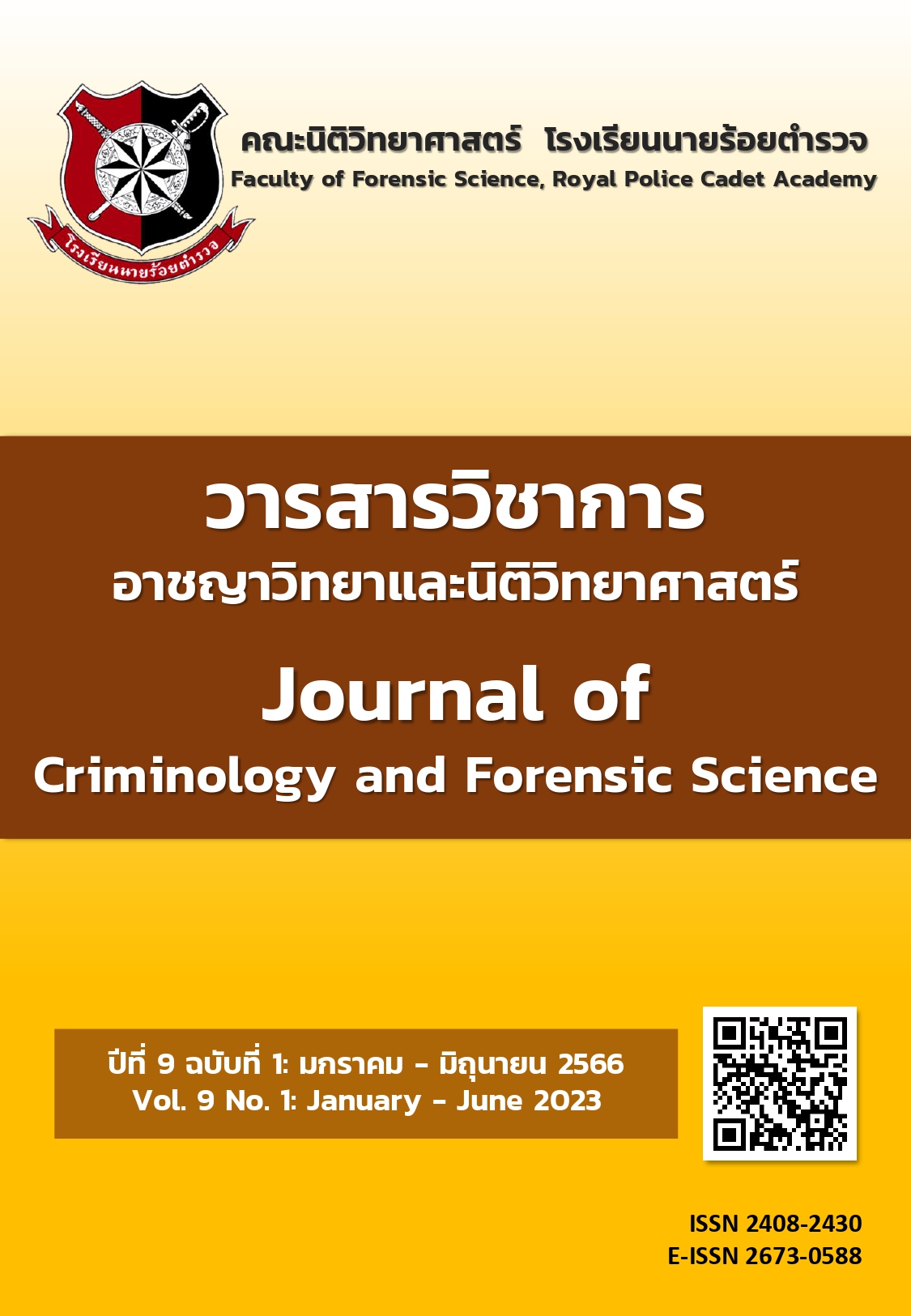การจัดการศพภายหลังสถานการณ์อุบัติภัย
Main Article Content
บทคัดย่อ
การจัดการผู้เสียชีวิตในกรณีเกิดอุบัติภัยเป็นสถานการณ์ที่มีความซับซ้อน จะต้องมีการจัดการศพอย่างเป็นระบบเพื่อให้สามารถพิสูจน์เอกลักษณ์บุคคลได้อย่างถูกต้องตามมาตรฐานสากล โดยอาศัยองค์ความรู้ทางนิติเวชศาสตร์และนิติวิทยาศาสตร์ กระบวนการพิสูจน์เอกลักษณ์บุคคลจำต้องอาศัยความร่วมมือของบุคลากรผู้เชี่ยวชาญทางด้านนิติเวชจากหลากหลายสาขาวิชาชีพ สำนักงานตำรวจแห่งชาติเป็นหน่วยงานหลักในการบริหารจัดการสถานการณ์ ในสถานการณ์ที่มีผู้เสียชีวิตจำนวนมากนั้นจะต้องมีการจัดสรร บุคลากร ทรัพยากร และสถานที่ให้พร้อมสำหรับปฏิบัติการเก็บกู้ศพ เก็บรักษาศพ ชันสูตรศพ พิสูจน์เอกลักษณ์บุคคล รวมถึงการบันทึกข้อมูลของผู้สูญหายจากทางครอบครัว ทั้งนี้ในกระบวนการพิสูจน์เอกลักษณ์บุคคลในประเทศไทยนั้น อ้างอิงแนวทางในการทำงานจากองค์กรตำรวจสากล (INTERPOL) โดยใช้การเก็บและเปรียบเทียบข้อมูลของผู้สูญหายกับข้อมูลของศพ ซึ่งมีการพิจารณาโดยคณะกรรมการพิสูจน์เอกลักษณ์บุคคล ในหลายองค์ประกอบ อาทิเช่น ลายพิมพ์นิ้วมือ ข้อมูลทางทันตกรรม สารพันธุกรรม และข้อมูลทางกายภาพ เป็นต้น ท้ายสุดเมื่อทราบว่าผู้ตายเป็นใครแล้วนั้นจะนำส่งร่างให้แก่ทางครอบครัวต่อไป
Article Details

อนุญาตภายใต้เงื่อนไข Creative Commons Attribution-NonCommercial-NoDerivatives 4.0 International License.
เนื้อหาและข้อมูลในบทความที่ลงตีพิมพ์ใน วารสารวิชาการอาชญาวิทยาและนิติวิทยาศาสตร์ โรงเรียนนายร้อยตำรวจ ถิอว่าเป็นข้อคิดเห็นและความรั้บผิดชอบของผู้เขียนบทความโดยตรงซึ่งกองบรรณาธิการวารสาร ไม่จำเป็นต้องเห็นด้วยหรือรับผิดชอบใดๆ
บทความ ข้อมูล เนื้อหา รูปภาพ ฯลฯ ที่ได้รับการตีพิมพ์ใน วารสารวิชาการอาชญาวิทยาและนิติวิทยาศาสตร์ ถือว่าเป็นลิขสิทธิ์ของวารสาร วารสารวิชาการอาชญาวิทยาและนิติวิทยาศาสตร์ หากบุคคลหรือหน่วยงานใดต้องการนำทั้งหมดหรือส่วนหนึ่งส่วนใดไปเผยแพร่ต่อหรือเพื่อกระทำการใดๆ จะต้องได้รับอนุญาตเป็นลายลักษณ์อักษรจาก วารสารวิชาการอาชญาวิทยาและนิติวิทยาศาสตร์ ก่อนเท่านั้น
เอกสารอ้างอิง
Byard, R. W., & Winskog, C. (2010). Potential problems arising during international disaster victim identification (DVI) exercises. Forensic Science, Medicine, and Pathology, 6, 1-2.
De Boer, H. H., Blau, S., Delabarde, T., & Hackman, L. (2019). The role of forensic anthropology in disaster victim identification (DVI): recent developments and future prospects. Forensic sciences research, 4(4), 303-315.
De Boer, H. H., Roberts, J., Delabarde, T., Mundorff, A. Z., & Blau, S. (2020). Disaster victim identification operations with fragmented, burnt, or commingled remains: experience-based recommendations. Forensic Sciences Research, 5(3), 191-201.
Disaster Prevention and Mitigation Act 2007. (2007, September 7). Royal Thai Government Gazette. Vol 124 part 52a pp. 1-23. (In Thai).
Institute of Forensic Medicine. (n.d.) Instruction for release the deceased. Retrieved June 28, 2022, from: https://shorturl.asia/UbF1B. (In Thai).
INTERPOL, (2018). INTERPOL disaster victim identification guide. Retrieved July 1, 2022, from: https://www.interpol.int/How-we-work/Forensics/Disaster-Victim-Identification-DVI
Lessig, R., & Rothschild, M. (2012). International standards in cases of mass disaster victim identification (DVI). Forensic science, medicine, and pathology, 8, 197-199.
Ministry of Public Health. (2021). Guideline for Dead bodies Management in Mass Disaster (1th ed.). Bangkok: Born to Be Publishing. (in Thai).
OC, D. S. (2010). INTERPOL DVI best-practice standards—an overview. Forensic science international, 201(1-3), 18-21.
Prinz, M., Carracedo, A., Mayr, W. R., Morling, N., Parsons, T. J., Sajantila, A.& Schneider, P. M. (2007). DNA Commission of the International Society for Forensic Genetics (ISFG): recommendations regarding the role of forensic genetics for disaster victim identification (DVI). Forensic Science International: Genetics, 1(1), 3-12.
Regulations of the Office of the Prime Minister to Support Missing Persons and Unidentified Bodies Management 2021. (2021, April 27). Royal Thai Government Gazette. Vol 138, Special part 89d pp. 1-5. (In Thai).
Royal Thai Police, (2009). Regulations of the Royal Thai Police on Police Code of Regulations related to Case Category 10 Postmortem Examination (Volume2) 2009. Retrieved July 1, 2022, from http://www.finance.police.go.th/userdata/dialynews/news011/files/ลักษณะที่%2010%20ฉ.2%20ปี%2052.pdf. (In Thai).
Royal Thai Police, (2015). Order of Royal Thai Police No. 725/2015 on Missing Persons and Unidentified Bodies Management. Retrieved July 9, 2022, from http://www.criminal.police.go.th/documents/INF25581228.pdf. (In Thai).
Schuliar, Y., & Knudsen, P. J. T. (2012). Role of forensic pathologists in mass disasters. Forensic science, medicine, and pathology, 8, 164-173.
Suwanjutha, T. (1993). The Forensic Medicine.(3th ed.). Bangkok: Bhapith Publication House; 1-3. (In Thai).
Thaikruea, L., & Seetamanotch, S. (2009). Lessons Learnt about the Thai Health Information System During the Tsunami Disaster, 2004-2007. Chiang Mai Med J, 48(1):1-13.
Ungpraphan, W. (2000). Guideline for the Development of Forensics in Justice System. (1th ed.). Bangkok: October Publication House; 195-196. (In Thai).


